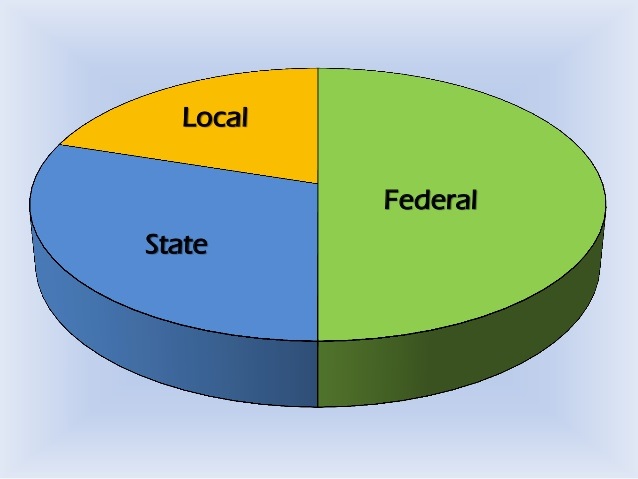Every tier of government in Nigeria depends largely on the statutory revenue allocation from the federation account to fund development projects and maintain their respective workforce. In this article, we’d discuss how revenue allocation works in Nigeria.

The revenue allocation in Nigeria would be discussed below:
-
The Types of Revenue Allocation in Nigeria
There are two ways that revenue from the federation account is allocated among the tiers of government in Nigeria. The revenue allocation models being used in Nigeria are the vertical allocation formula and the horizontal allocation formula. The former deals with sharing of revenue among the federal, state and local governments, while the latter involves the disbursement of financial resources to the 36 states and the 774 local government councils of the federation.
Let’s discuss the two revenue allocation models in use in Nigeria below.
-
Vertical Allocation
The vertical allocation model of revenue allocation in Nigeria involves sharing financial resources among the federal, state, and local tiers of government from the federation account. The federation account is likened to a central purse of the country.
There is a laid-down formula that guides how the financial resources disbursed from the federation account are shared among the three tiers of government. According to the vertical allocation formula, the federal government receives 52.68% of the federation account while the 36 states share 26.72%. The remaining 20.60% is shared among the 774 local government areas of the country.
The 52.68% of the federation account that goes to the federal government is not all for federal government expenditure. After the statutory deductions, the federal government is only granted 48.5% for use while the remaining 4.18% is managed by the federal government for the federal capital territory (FCT), statutory stabilization (also known as saving for the rainy days), general ecological problem, and development of natural resources. The 4.18% is shared thus: FCT gets 1%; general ecological problem gets 1%; development of natural resources gets 1.68%; and statutory stabilization gets 0.5%.
-
Horizontal Allocation
The horizontal allocation model of revenue allocation is all about how the 36 states and the 774 local government councils share the allocated revenue disbursed during the vertical allocation. In the vertical allocation of revenue, the 36 states get 26.72% of the federation account while the 774 Local government councils share 20.60%.
Certain principles guide how the states and local government councils share the financial resources in the horizontal allocation model. These principles are based on five factors, namely: equality, population, internally generated revenue, social development factor, and landmass/terrain.
In the horizontal allocation of revenue model, the equality principle specifies that the 36 states of Nigeria share 40% of the 26.72% disbursed to states in the vertical allocation formula. For instance, if the 36 states got N100 (26.72% of the federation account), the equality principle says the 36 states should share N40 equally – N1.11 each.
The population principle of the horizontal allocation model directs that 30% of the 26.72% of the federation account is disbursed to the states based on their respective population. Still maintaining the hypothetical figure we used in explaining the equality principle sharing formula, it means the 36 states would share N30 (30% of N100) based on their respective population as determined by the National Population Commission.
The landmass/terrain principle of the horizontal allocation model declares that 10% of the revenue allocated for the 36 states of the federation to share is based on the landmass and terrain of each state. Based on this allocation principle, the revenue a state gets is split 50% for its landmass and 50% for the terrain present in the state.
To get the proportional areal size of the landmass of each state, the following formula is employed:
Proportional Areal Size for each state = Areal Size of Atate × 100 ÷ Total Areal Size of Nigeria
On the other hand, the allocation a state gets for terrain is calculated based on the proportional areal size of the wetlands, plains, and highlands present in a state.
The principle of the horizontal allocation based on the internally generated revenue is that the 36 states contribute 10 percent of their respective IGR into a joint state and local government account. This would then be shared equally.
The social development factor principle of the horizontal allocation formula directs that 10% of the revenue received by the 36 states be disbursed for health, education and water. The sharing formula here is 4% for education while water and health get 3% each.
The 4% allocated for education in the social development principle is disbursed according to the number of enrolments in state-funded primary and secondary schools in a state. Enrolment in state-funded primary schools attracts 60% of the allocation to education, while 40% is for secondary school enrolment. Half of the allocation a state receives based on secondary school enrolment is made in direct proportion to school enrolment, while the other half is made in inverse proportion to school enrolment.
The allocation states receive based on the health parameter of the social development factor principle is based on the number of state-owned beds in hospitals. And 50% of the allocation is made in direct proportion to the number of state-owned beds, while the other half is inversely proportional to the number of state-owned beds.
The water parameter of the social development factor in the horizontal revenue allocation model relates to the mean annual rainfall in the state headquarters and the territorial spread of each of the 36 states.
The 774 local government councils of the federation share 20.60% of revenue from the federation account using the same five principles of the horizontal allocation model we explained above. That means the principles of equality, population, internally generated revenue, social development factor, and landmass/terrain are used to calculate how to disburse the allocated revenue to each local government council in Nigeria.